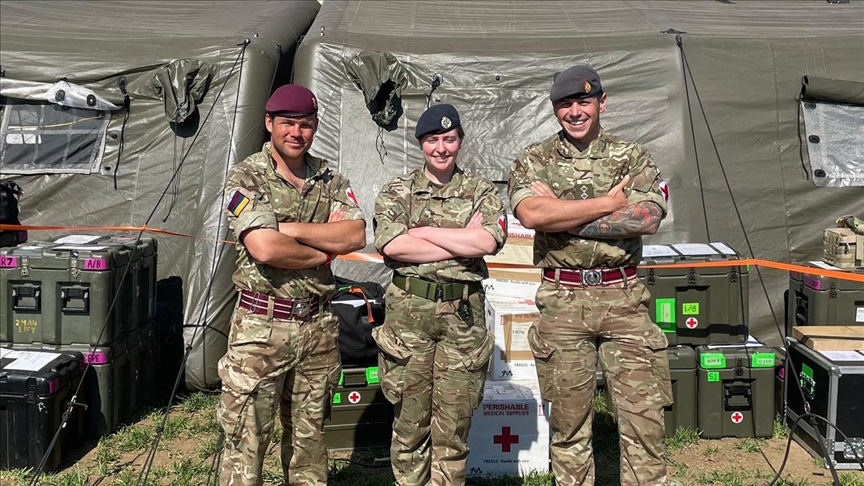

By Anadolu Agency
KAHRAMANMARAS, Türkiye
British Army Airborne medics had some unforgettable experiences while treating earthquake victims at a medical facility in Türkiye’s Kahramanmaras province, the epicenter of the massive Feb. 6 tremors.
A total of 100 soldiers, including 70 clinical staff from the 16 Medical Regiment based in Colchester, England, arrived in Türkiye on Feb. 14 to provide treatment for those affected by the earthquakes that struck the south of the country.
Maj. Sean Mason, 35, the officer commanding the medical group, has been in charge of medics and facilities established in the Turkoglu district of Kahrmanmaras.
Mason said he was impressed by the resilience of the Turkish people despite the terrible situation they found themselves facing.
“The situation here and what the Turkish people have had to go through after the earthquake has been really quite profound. It’s been heartening certainly for me and my soldiers,” he told Anadolu in an interview.
The British medical team provided some technical equipment, including X-rays and radiography, which was temporarily unavailable to Turkish doctors on the first days after the quake.
“The Turkish medical team and the UK emergency medical team were already intercompany when we arrived in Kahramanmaras. We also bring another number of other experts, in terms of general practitioner doctors, and just our junior medics are able to help out, that you need to run a hospital or medical facility.”
He praised the capability of the Turkish healthcare system despite it facing a patient overload following the twin earthquakes.
“It is quite remarkable how quickly they (Turkish medical staff) have been able to get back to a normal pattern of life, and have been dealing with the huge numbers of patients that they’ve been having to deal with.”
So far, more than 100 patients have been treated in the facility, which provides two health care with intensive care beds, an emergency department, and a field mental health nurse.
“Many of the injuries that we’ve been able to help, with a big proportion of them, have been people who have been suffering from injuries or illnesses in the immediate aftermath of the earthquake.”
‘First time doing anything like this. I’m very proud to be able to help other people’
Speaking to Anadolu, Corp. Lucy Whitehouse, 27, a specialist burns nurse, said they treated lots of pediatric patients with burns in their facility.
“I was able to kind of work with the Turkish nurses to begin to develop their sort of knowledge of how we manage burns in the UK. A lot of injured people came through from the initial earthquake.”
“It’s my first time doing anything like this. I’m very proud to be able to help other people,” she said.
“I just went out to see a patient and family up there and they seemed very thankful. They asked to see me in the future. So it’s kind of like that, that impact that you’re having on them.”
She had some emotional moments while taking care of children.
“I’m a nurse for adults. I never looked after children until arriving here. So, that’s been particularly hard for me. Because recovering the children with burns, it’s hard enough for anyone let alone the parents, staff.”
Acknowledging that the experience in Kahramanmaras changed her practice of nursing, Whitehouse said: “In the UK, we see vulnerable patients as well. But, over here, we’re seeing a completely different sort of state of play. Patients lost a lot of things here.”
Turkish and British emergency medical teams also provide services including an emergency department, pediatrics, and women’s health close to British Army Airborne medics in the same area.
Fears following quakes
Richard Ainsworth-Masiello, a mental health nurse, took care of approximately 50 Turkish patients so far.
Asked what kind of illness he mostly faced, he said: “There’s a mixture of panic disorders and acute anxiety because the earthquakes have just happened. People have fear of further earthquakes with the tremors, fear of some of the buildings collapsing,” he told Anadolu.
“We’re also getting a lot of people who suffer low mood, a lot of depression, and grief for people that have been lost as well.”
Ainsworth-Masiello had a 91-year-old patient who was brought in by her daughter and her husband. It was a quite challenging situation for his work, since her patient was completely blind, partially deaf, and had panic attacks.
“She’s not mobilizing well and that’s a really tricky situation,” he explained. “The world is scary enough as it is for a 91-year-old but we learned through using touching and talking we were able to calm her. We put a plan in place with the family to support her. Something very unusual to my normal practice and challenging, but we’re able to work and come up with a plan to support the person. ”
At least 43,500 people were killed by two strong earthquakes that jolted southern Türkiye on Feb. 6.
The magnitude 7.7 and 7.6 earthquakes, centered in the Kahramanmaras province, affected more than 13 million people across 11 provinces, including Adana, Adiyaman, Diyarbakir, Gaziantep, Hatay, Kilis, Malatya, Osmaniye, Elazig, and Sanliurfa.
We use cookies on our website to give you a better experience, improve performance, and for analytics. For more information, please see our Cookie Policy By clicking “Accept” you agree to our use of cookies.
Read More